Assessment of Digital Systems in Healthcare: A Research Proposal
VerifiedAdded on 2023/06/11
|17
|3889
|479
Report
AI Summary
This research proposal investigates the importance of digital health systems in healthcare, focusing on their multidisciplinary approach and potential to enhance the quality of healthcare services. The study aims to understand how these systems improve healthcare quality, promote self-care, and serve as effective educational tools. Using a positivist research philosophy and a deductive approach, the proposal outlines a methodology involving surveys and statistical analysis to evaluate the benefits of digital health systems. It also addresses potential limitations such as sample size and researcher bias, while emphasizing the significance of construct validity in data collection. This document, contributed by a student and available on Desklib, provides insights into the application of digital technologies in modern healthcare settings.

Running head: RESEARCH PROPOSAL
Research Proposal
Name of the student
University name
Author’s note
Research Proposal
Name of the student
University name
Author’s note
Paraphrase This Document
Need a fresh take? Get an instant paraphrase of this document with our AI Paraphraser
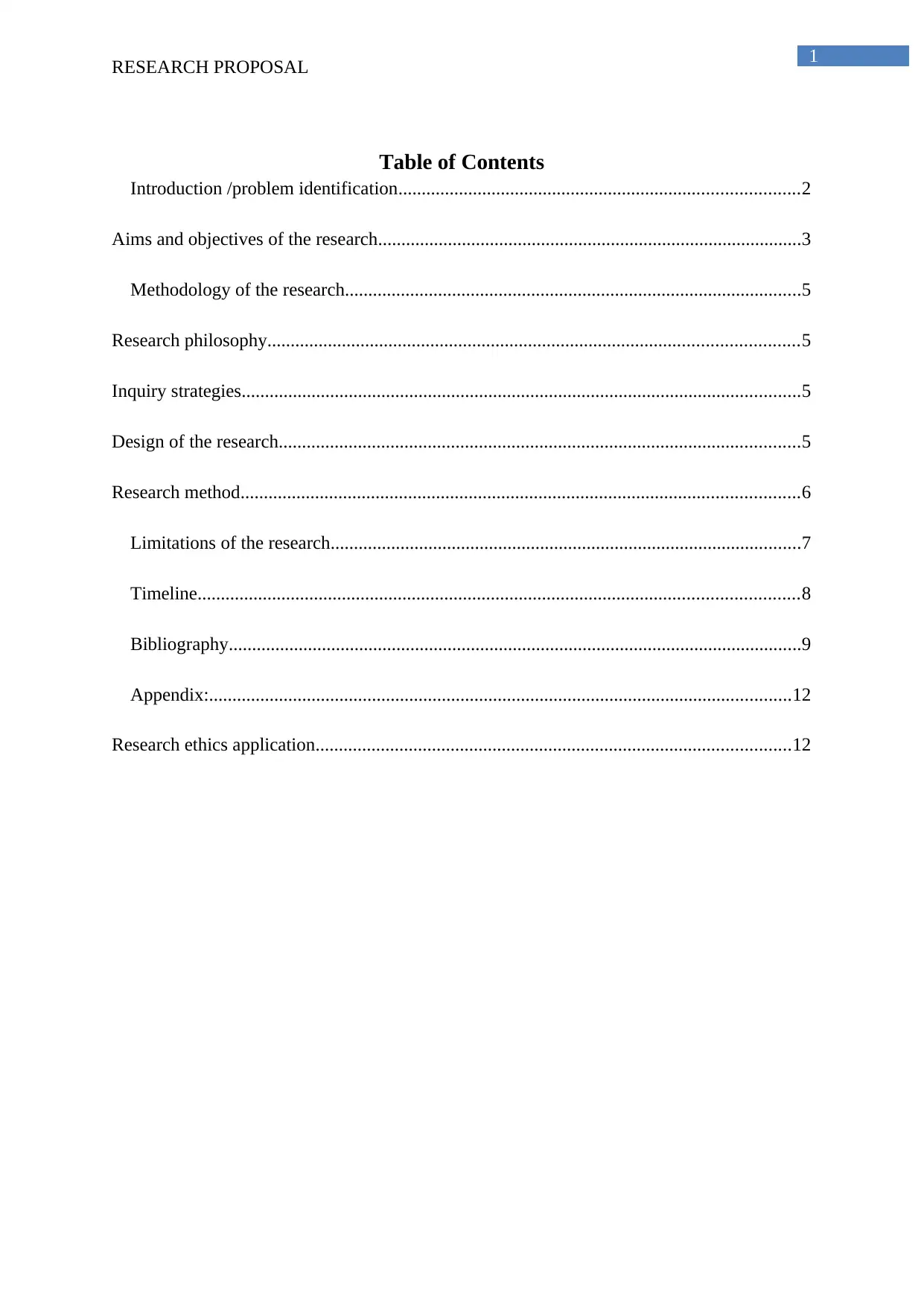
1
RESEARCH PROPOSAL
Table of Contents
Introduction /problem identification......................................................................................2
Aims and objectives of the research...........................................................................................3
Methodology of the research..................................................................................................5
Research philosophy..................................................................................................................5
Inquiry strategies........................................................................................................................5
Design of the research................................................................................................................5
Research method........................................................................................................................6
Limitations of the research.....................................................................................................7
Timeline.................................................................................................................................8
Bibliography...........................................................................................................................9
Appendix:.............................................................................................................................12
Research ethics application......................................................................................................12
RESEARCH PROPOSAL
Table of Contents
Introduction /problem identification......................................................................................2
Aims and objectives of the research...........................................................................................3
Methodology of the research..................................................................................................5
Research philosophy..................................................................................................................5
Inquiry strategies........................................................................................................................5
Design of the research................................................................................................................5
Research method........................................................................................................................6
Limitations of the research.....................................................................................................7
Timeline.................................................................................................................................8
Bibliography...........................................................................................................................9
Appendix:.............................................................................................................................12
Research ethics application......................................................................................................12
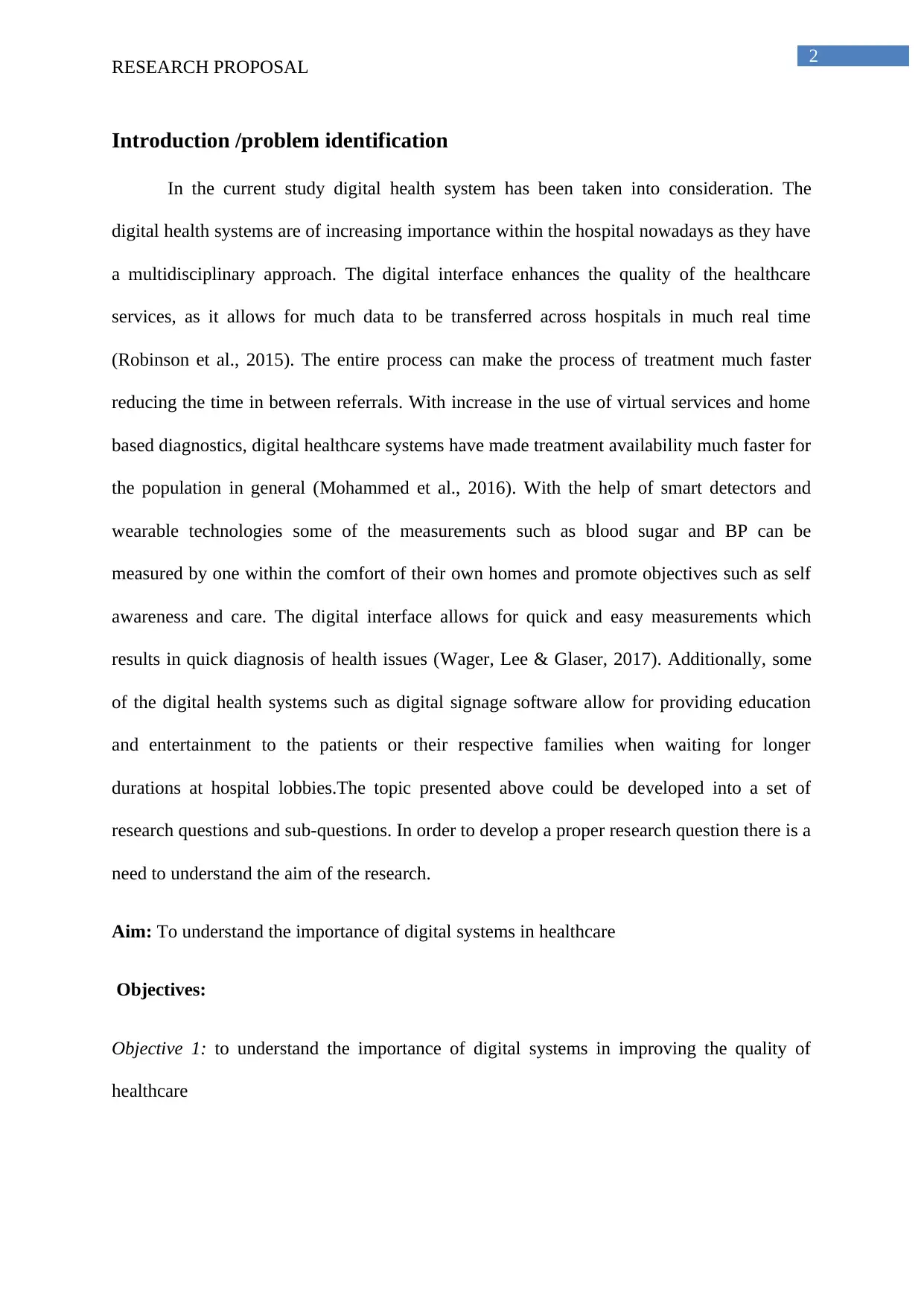
2
RESEARCH PROPOSAL
Introduction /problem identification
In the current study digital health system has been taken into consideration. The
digital health systems are of increasing importance within the hospital nowadays as they have
a multidisciplinary approach. The digital interface enhances the quality of the healthcare
services, as it allows for much data to be transferred across hospitals in much real time
(Robinson et al., 2015). The entire process can make the process of treatment much faster
reducing the time in between referrals. With increase in the use of virtual services and home
based diagnostics, digital healthcare systems have made treatment availability much faster for
the population in general (Mohammed et al., 2016). With the help of smart detectors and
wearable technologies some of the measurements such as blood sugar and BP can be
measured by one within the comfort of their own homes and promote objectives such as self
awareness and care. The digital interface allows for quick and easy measurements which
results in quick diagnosis of health issues (Wager, Lee & Glaser, 2017). Additionally, some
of the digital health systems such as digital signage software allow for providing education
and entertainment to the patients or their respective families when waiting for longer
durations at hospital lobbies.The topic presented above could be developed into a set of
research questions and sub-questions. In order to develop a proper research question there is a
need to understand the aim of the research.
Aim: To understand the importance of digital systems in healthcare
Objectives:
Objective 1: to understand the importance of digital systems in improving the quality of
healthcare
RESEARCH PROPOSAL
Introduction /problem identification
In the current study digital health system has been taken into consideration. The
digital health systems are of increasing importance within the hospital nowadays as they have
a multidisciplinary approach. The digital interface enhances the quality of the healthcare
services, as it allows for much data to be transferred across hospitals in much real time
(Robinson et al., 2015). The entire process can make the process of treatment much faster
reducing the time in between referrals. With increase in the use of virtual services and home
based diagnostics, digital healthcare systems have made treatment availability much faster for
the population in general (Mohammed et al., 2016). With the help of smart detectors and
wearable technologies some of the measurements such as blood sugar and BP can be
measured by one within the comfort of their own homes and promote objectives such as self
awareness and care. The digital interface allows for quick and easy measurements which
results in quick diagnosis of health issues (Wager, Lee & Glaser, 2017). Additionally, some
of the digital health systems such as digital signage software allow for providing education
and entertainment to the patients or their respective families when waiting for longer
durations at hospital lobbies.The topic presented above could be developed into a set of
research questions and sub-questions. In order to develop a proper research question there is a
need to understand the aim of the research.
Aim: To understand the importance of digital systems in healthcare
Objectives:
Objective 1: to understand the importance of digital systems in improving the quality of
healthcare
⊘ This is a preview!⊘
Do you want full access?
Subscribe today to unlock all pages.

Trusted by 1+ million students worldwide
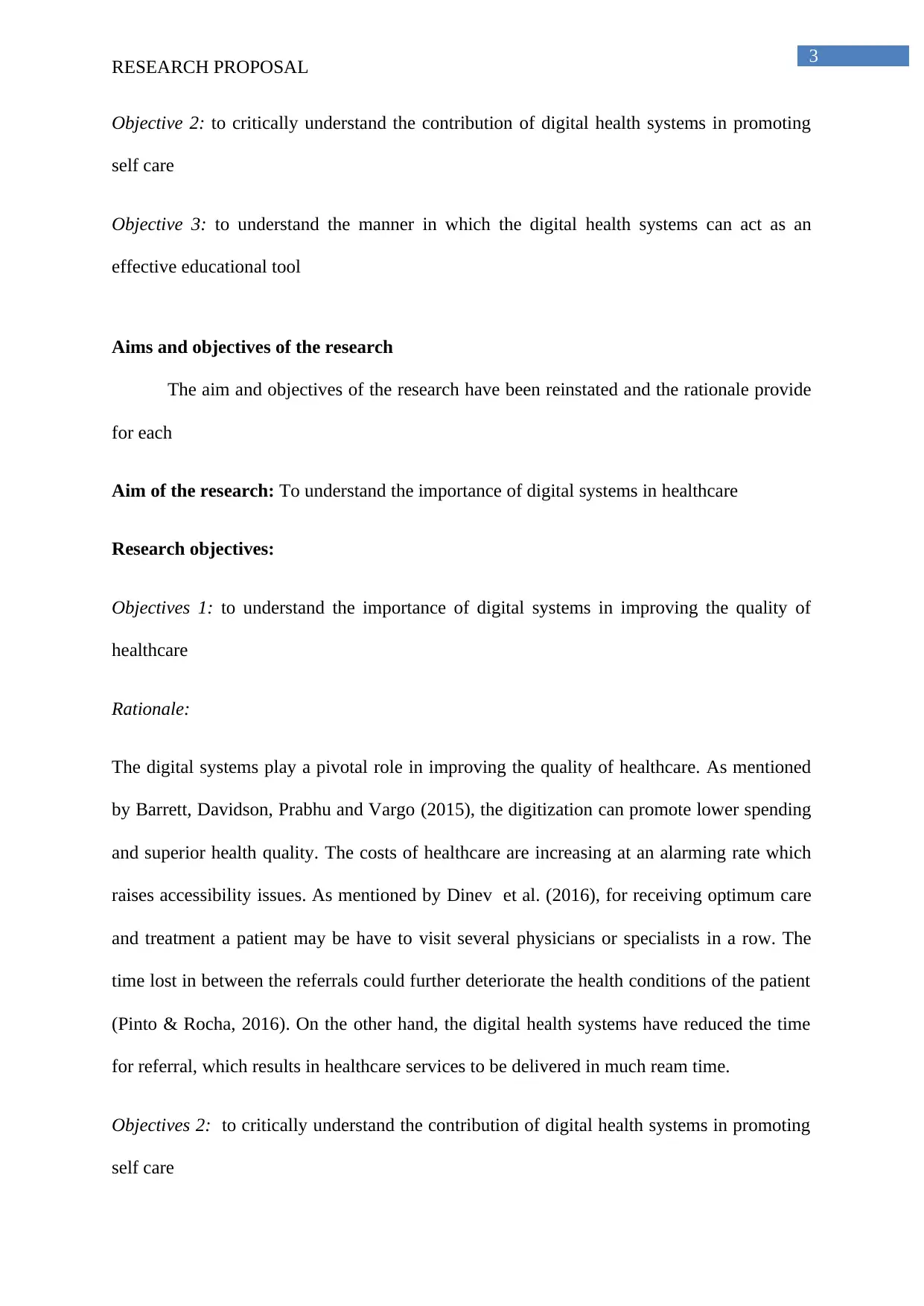
3
RESEARCH PROPOSAL
Objective 2: to critically understand the contribution of digital health systems in promoting
self care
Objective 3: to understand the manner in which the digital health systems can act as an
effective educational tool
Aims and objectives of the research
The aim and objectives of the research have been reinstated and the rationale provide
for each
Aim of the research: To understand the importance of digital systems in healthcare
Research objectives:
Objectives 1: to understand the importance of digital systems in improving the quality of
healthcare
Rationale:
The digital systems play a pivotal role in improving the quality of healthcare. As mentioned
by Barrett, Davidson, Prabhu and Vargo (2015), the digitization can promote lower spending
and superior health quality. The costs of healthcare are increasing at an alarming rate which
raises accessibility issues. As mentioned by Dinev et al. (2016), for receiving optimum care
and treatment a patient may be have to visit several physicians or specialists in a row. The
time lost in between the referrals could further deteriorate the health conditions of the patient
(Pinto & Rocha, 2016). On the other hand, the digital health systems have reduced the time
for referral, which results in healthcare services to be delivered in much ream time.
Objectives 2: to critically understand the contribution of digital health systems in promoting
self care
RESEARCH PROPOSAL
Objective 2: to critically understand the contribution of digital health systems in promoting
self care
Objective 3: to understand the manner in which the digital health systems can act as an
effective educational tool
Aims and objectives of the research
The aim and objectives of the research have been reinstated and the rationale provide
for each
Aim of the research: To understand the importance of digital systems in healthcare
Research objectives:
Objectives 1: to understand the importance of digital systems in improving the quality of
healthcare
Rationale:
The digital systems play a pivotal role in improving the quality of healthcare. As mentioned
by Barrett, Davidson, Prabhu and Vargo (2015), the digitization can promote lower spending
and superior health quality. The costs of healthcare are increasing at an alarming rate which
raises accessibility issues. As mentioned by Dinev et al. (2016), for receiving optimum care
and treatment a patient may be have to visit several physicians or specialists in a row. The
time lost in between the referrals could further deteriorate the health conditions of the patient
(Pinto & Rocha, 2016). On the other hand, the digital health systems have reduced the time
for referral, which results in healthcare services to be delivered in much ream time.
Objectives 2: to critically understand the contribution of digital health systems in promoting
self care
Paraphrase This Document
Need a fresh take? Get an instant paraphrase of this document with our AI Paraphraser
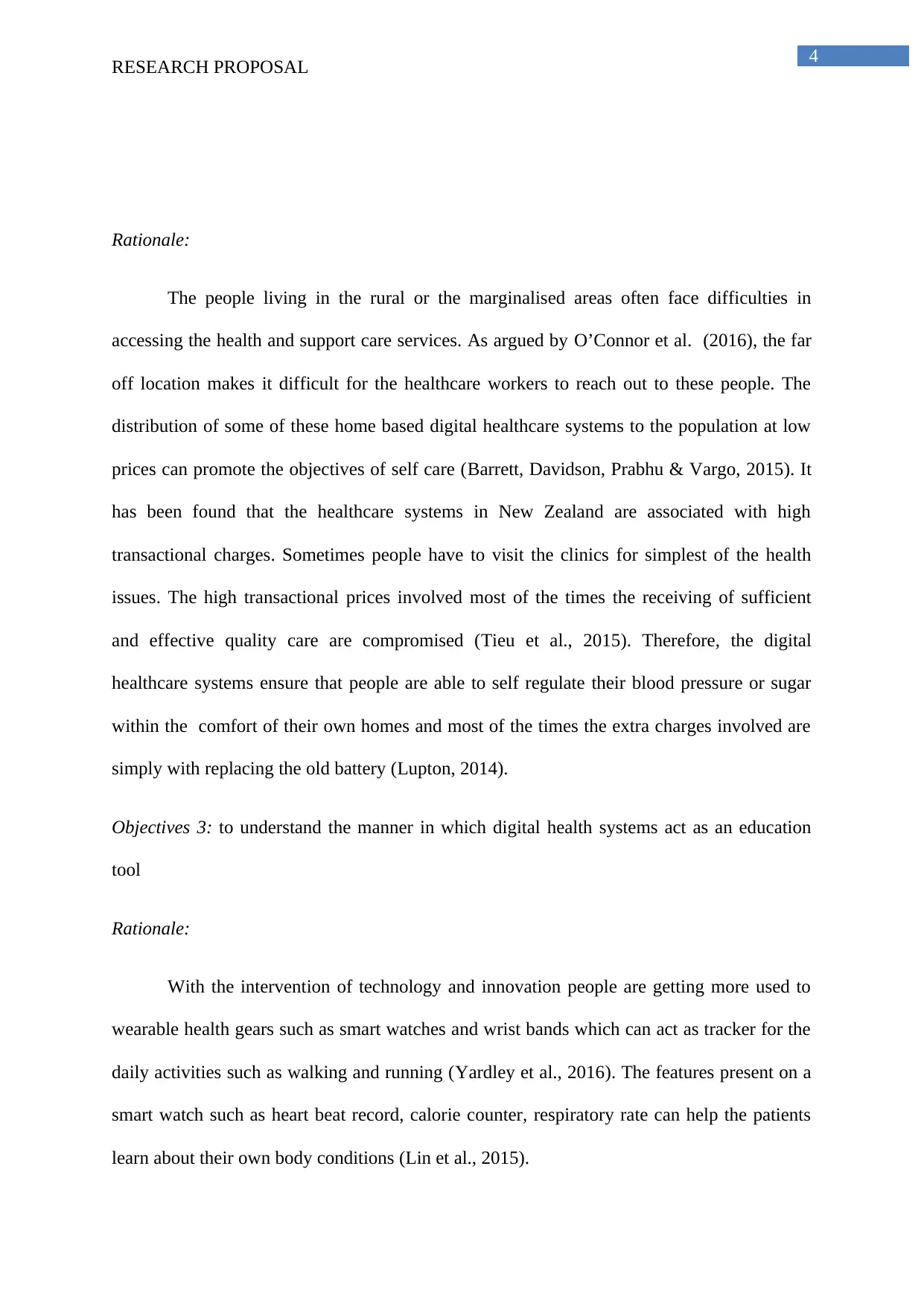
4
RESEARCH PROPOSAL
Rationale:
The people living in the rural or the marginalised areas often face difficulties in
accessing the health and support care services. As argued by O’Connor et al. (2016), the far
off location makes it difficult for the healthcare workers to reach out to these people. The
distribution of some of these home based digital healthcare systems to the population at low
prices can promote the objectives of self care (Barrett, Davidson, Prabhu & Vargo, 2015). It
has been found that the healthcare systems in New Zealand are associated with high
transactional charges. Sometimes people have to visit the clinics for simplest of the health
issues. The high transactional prices involved most of the times the receiving of sufficient
and effective quality care are compromised (Tieu et al., 2015). Therefore, the digital
healthcare systems ensure that people are able to self regulate their blood pressure or sugar
within the comfort of their own homes and most of the times the extra charges involved are
simply with replacing the old battery (Lupton, 2014).
Objectives 3: to understand the manner in which digital health systems act as an education
tool
Rationale:
With the intervention of technology and innovation people are getting more used to
wearable health gears such as smart watches and wrist bands which can act as tracker for the
daily activities such as walking and running (Yardley et al., 2016). The features present on a
smart watch such as heart beat record, calorie counter, respiratory rate can help the patients
learn about their own body conditions (Lin et al., 2015).
RESEARCH PROPOSAL
Rationale:
The people living in the rural or the marginalised areas often face difficulties in
accessing the health and support care services. As argued by O’Connor et al. (2016), the far
off location makes it difficult for the healthcare workers to reach out to these people. The
distribution of some of these home based digital healthcare systems to the population at low
prices can promote the objectives of self care (Barrett, Davidson, Prabhu & Vargo, 2015). It
has been found that the healthcare systems in New Zealand are associated with high
transactional charges. Sometimes people have to visit the clinics for simplest of the health
issues. The high transactional prices involved most of the times the receiving of sufficient
and effective quality care are compromised (Tieu et al., 2015). Therefore, the digital
healthcare systems ensure that people are able to self regulate their blood pressure or sugar
within the comfort of their own homes and most of the times the extra charges involved are
simply with replacing the old battery (Lupton, 2014).
Objectives 3: to understand the manner in which digital health systems act as an education
tool
Rationale:
With the intervention of technology and innovation people are getting more used to
wearable health gears such as smart watches and wrist bands which can act as tracker for the
daily activities such as walking and running (Yardley et al., 2016). The features present on a
smart watch such as heart beat record, calorie counter, respiratory rate can help the patients
learn about their own body conditions (Lin et al., 2015).
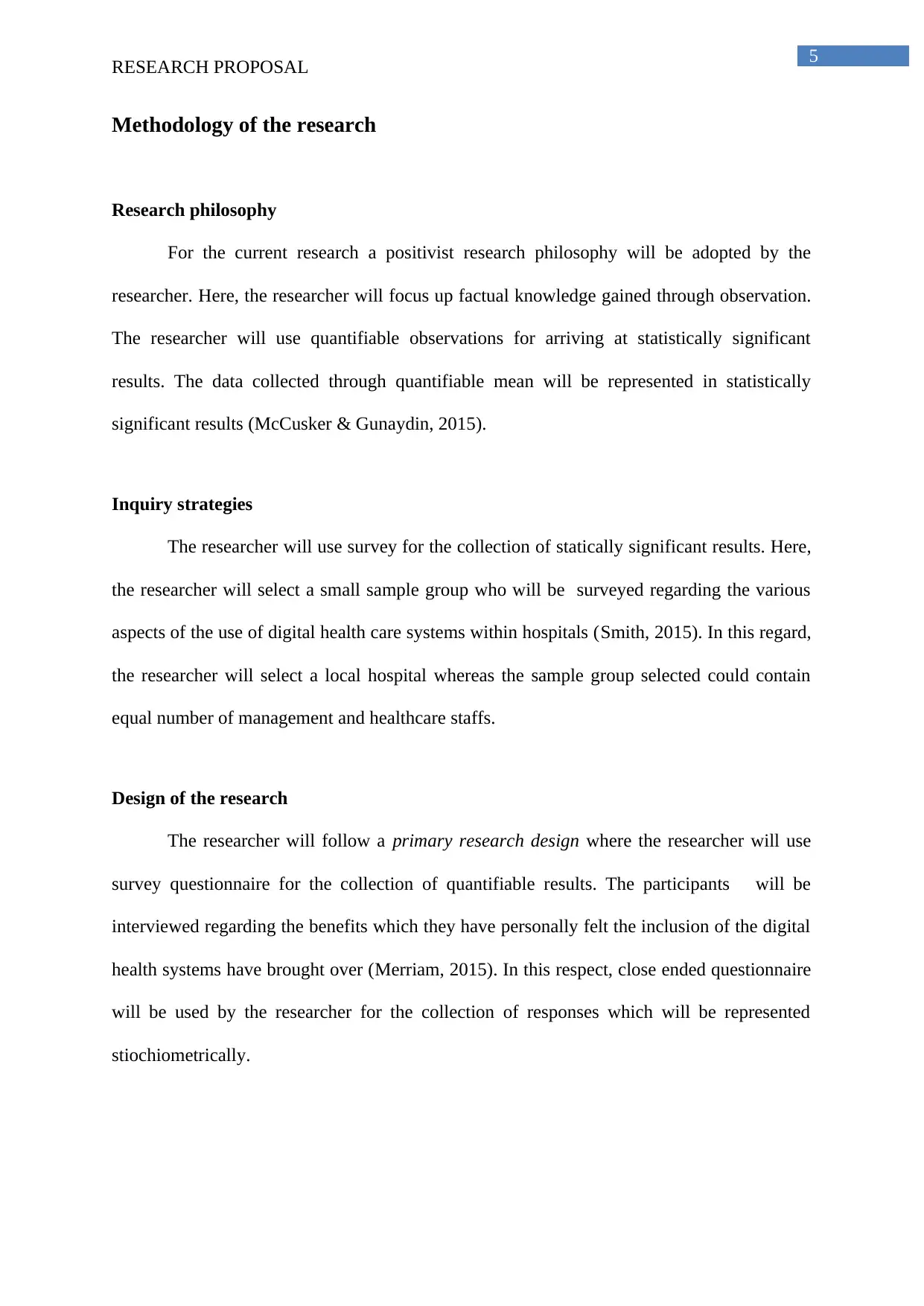
5
RESEARCH PROPOSAL
Methodology of the research
Research philosophy
For the current research a positivist research philosophy will be adopted by the
researcher. Here, the researcher will focus up factual knowledge gained through observation.
The researcher will use quantifiable observations for arriving at statistically significant
results. The data collected through quantifiable mean will be represented in statistically
significant results (McCusker & Gunaydin, 2015).
Inquiry strategies
The researcher will use survey for the collection of statically significant results. Here,
the researcher will select a small sample group who will be surveyed regarding the various
aspects of the use of digital health care systems within hospitals (Smith, 2015). In this regard,
the researcher will select a local hospital whereas the sample group selected could contain
equal number of management and healthcare staffs.
Design of the research
The researcher will follow a primary research design where the researcher will use
survey questionnaire for the collection of quantifiable results. The participants will be
interviewed regarding the benefits which they have personally felt the inclusion of the digital
health systems have brought over (Merriam, 2015). In this respect, close ended questionnaire
will be used by the researcher for the collection of responses which will be represented
stiochiometrically.
RESEARCH PROPOSAL
Methodology of the research
Research philosophy
For the current research a positivist research philosophy will be adopted by the
researcher. Here, the researcher will focus up factual knowledge gained through observation.
The researcher will use quantifiable observations for arriving at statistically significant
results. The data collected through quantifiable mean will be represented in statistically
significant results (McCusker & Gunaydin, 2015).
Inquiry strategies
The researcher will use survey for the collection of statically significant results. Here,
the researcher will select a small sample group who will be surveyed regarding the various
aspects of the use of digital health care systems within hospitals (Smith, 2015). In this regard,
the researcher will select a local hospital whereas the sample group selected could contain
equal number of management and healthcare staffs.
Design of the research
The researcher will follow a primary research design where the researcher will use
survey questionnaire for the collection of quantifiable results. The participants will be
interviewed regarding the benefits which they have personally felt the inclusion of the digital
health systems have brought over (Merriam, 2015). In this respect, close ended questionnaire
will be used by the researcher for the collection of responses which will be represented
stiochiometrically.
⊘ This is a preview!⊘
Do you want full access?
Subscribe today to unlock all pages.

Trusted by 1+ million students worldwide
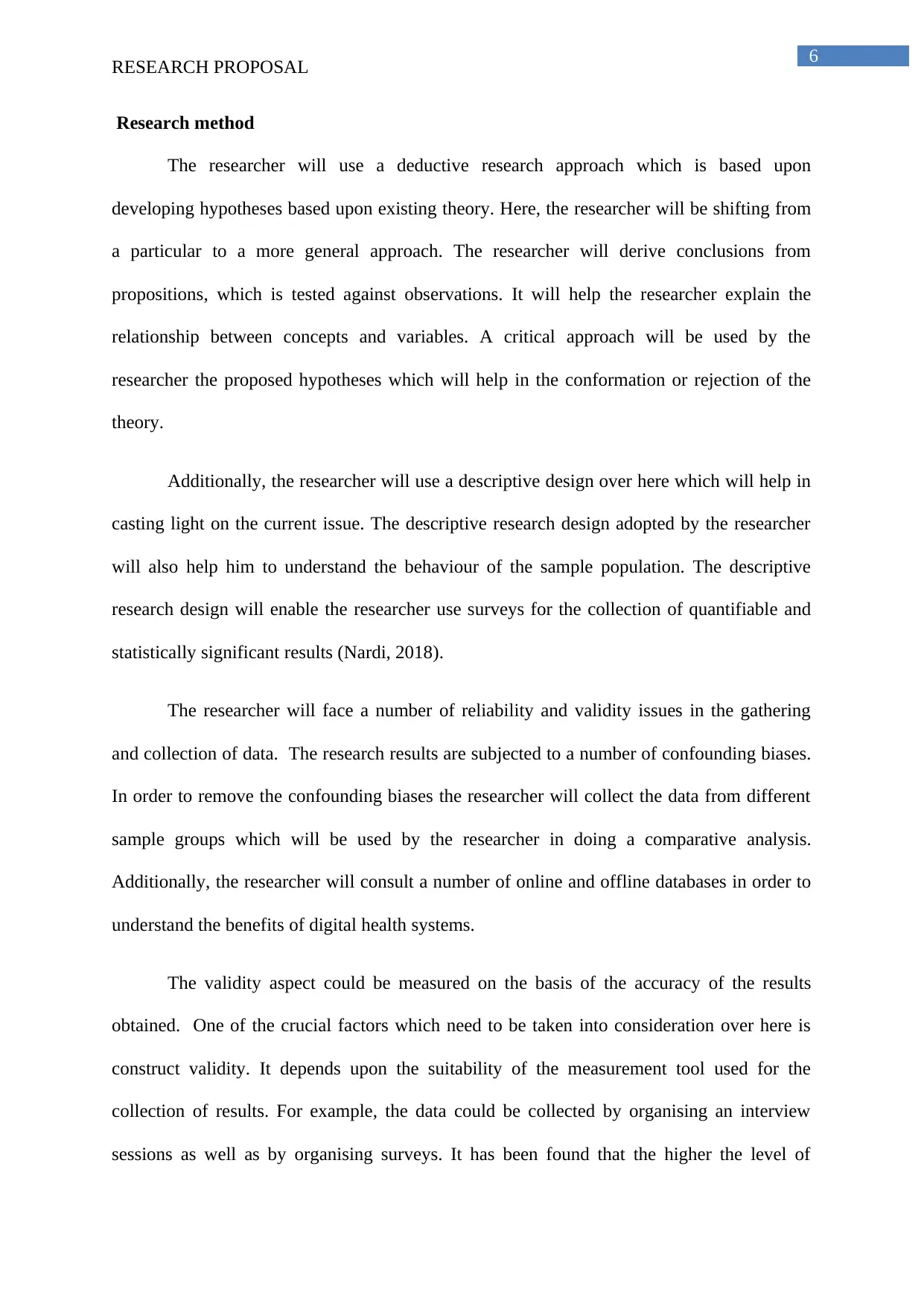
6
RESEARCH PROPOSAL
Research method
The researcher will use a deductive research approach which is based upon
developing hypotheses based upon existing theory. Here, the researcher will be shifting from
a particular to a more general approach. The researcher will derive conclusions from
propositions, which is tested against observations. It will help the researcher explain the
relationship between concepts and variables. A critical approach will be used by the
researcher the proposed hypotheses which will help in the conformation or rejection of the
theory.
Additionally, the researcher will use a descriptive design over here which will help in
casting light on the current issue. The descriptive research design adopted by the researcher
will also help him to understand the behaviour of the sample population. The descriptive
research design will enable the researcher use surveys for the collection of quantifiable and
statistically significant results (Nardi, 2018).
The researcher will face a number of reliability and validity issues in the gathering
and collection of data. The research results are subjected to a number of confounding biases.
In order to remove the confounding biases the researcher will collect the data from different
sample groups which will be used by the researcher in doing a comparative analysis.
Additionally, the researcher will consult a number of online and offline databases in order to
understand the benefits of digital health systems.
The validity aspect could be measured on the basis of the accuracy of the results
obtained. One of the crucial factors which need to be taken into consideration over here is
construct validity. It depends upon the suitability of the measurement tool used for the
collection of results. For example, the data could be collected by organising an interview
sessions as well as by organising surveys. It has been found that the higher the level of
RESEARCH PROPOSAL
Research method
The researcher will use a deductive research approach which is based upon
developing hypotheses based upon existing theory. Here, the researcher will be shifting from
a particular to a more general approach. The researcher will derive conclusions from
propositions, which is tested against observations. It will help the researcher explain the
relationship between concepts and variables. A critical approach will be used by the
researcher the proposed hypotheses which will help in the conformation or rejection of the
theory.
Additionally, the researcher will use a descriptive design over here which will help in
casting light on the current issue. The descriptive research design adopted by the researcher
will also help him to understand the behaviour of the sample population. The descriptive
research design will enable the researcher use surveys for the collection of quantifiable and
statistically significant results (Nardi, 2018).
The researcher will face a number of reliability and validity issues in the gathering
and collection of data. The research results are subjected to a number of confounding biases.
In order to remove the confounding biases the researcher will collect the data from different
sample groups which will be used by the researcher in doing a comparative analysis.
Additionally, the researcher will consult a number of online and offline databases in order to
understand the benefits of digital health systems.
The validity aspect could be measured on the basis of the accuracy of the results
obtained. One of the crucial factors which need to be taken into consideration over here is
construct validity. It depends upon the suitability of the measurement tool used for the
collection of results. For example, the data could be collected by organising an interview
sessions as well as by organising surveys. It has been found that the higher the level of
Paraphrase This Document
Need a fresh take? Get an instant paraphrase of this document with our AI Paraphraser
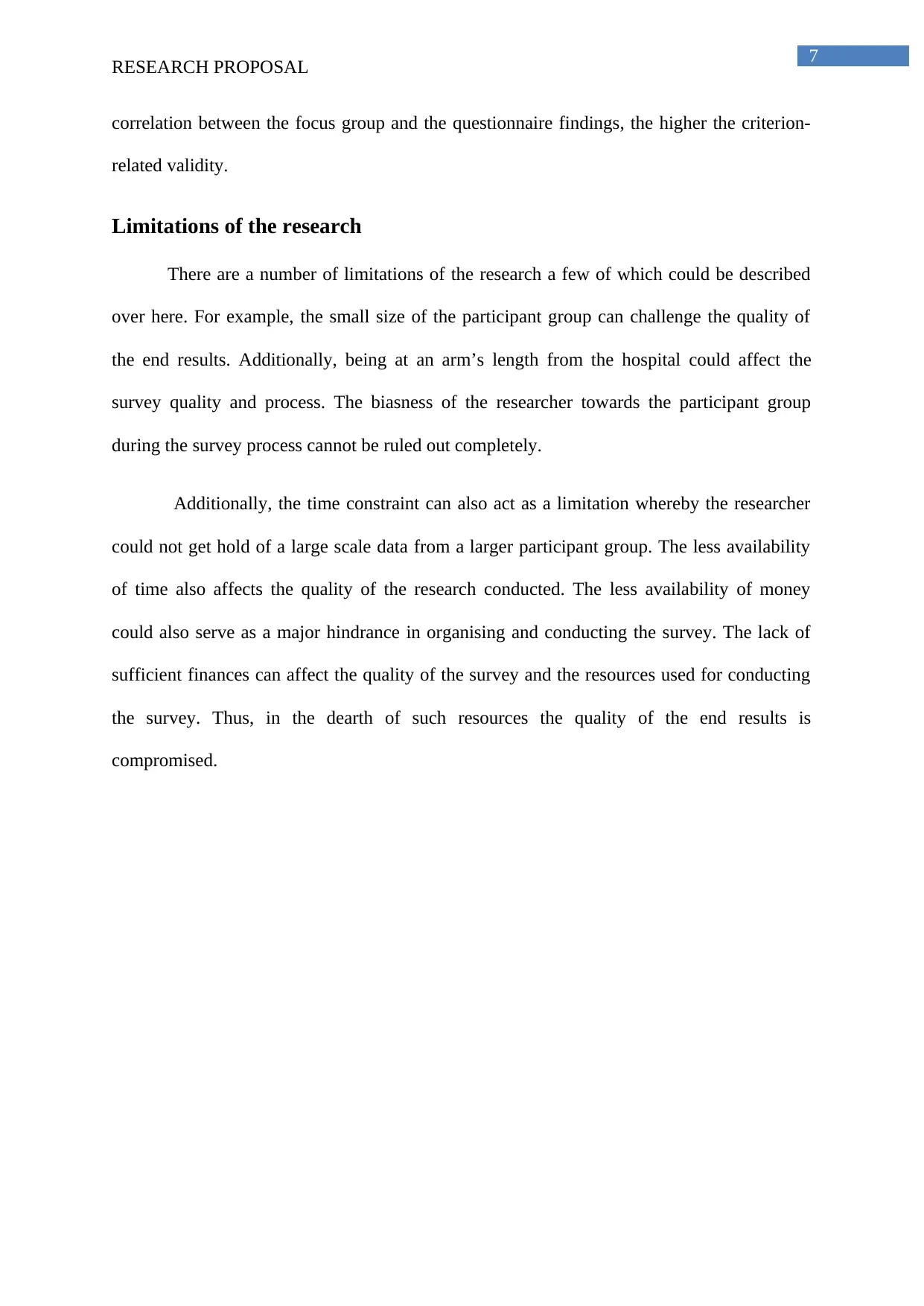
7
RESEARCH PROPOSAL
correlation between the focus group and the questionnaire findings, the higher the criterion-
related validity.
Limitations of the research
There are a number of limitations of the research a few of which could be described
over here. For example, the small size of the participant group can challenge the quality of
the end results. Additionally, being at an arm’s length from the hospital could affect the
survey quality and process. The biasness of the researcher towards the participant group
during the survey process cannot be ruled out completely.
Additionally, the time constraint can also act as a limitation whereby the researcher
could not get hold of a large scale data from a larger participant group. The less availability
of time also affects the quality of the research conducted. The less availability of money
could also serve as a major hindrance in organising and conducting the survey. The lack of
sufficient finances can affect the quality of the survey and the resources used for conducting
the survey. Thus, in the dearth of such resources the quality of the end results is
compromised.
RESEARCH PROPOSAL
correlation between the focus group and the questionnaire findings, the higher the criterion-
related validity.
Limitations of the research
There are a number of limitations of the research a few of which could be described
over here. For example, the small size of the participant group can challenge the quality of
the end results. Additionally, being at an arm’s length from the hospital could affect the
survey quality and process. The biasness of the researcher towards the participant group
during the survey process cannot be ruled out completely.
Additionally, the time constraint can also act as a limitation whereby the researcher
could not get hold of a large scale data from a larger participant group. The less availability
of time also affects the quality of the research conducted. The less availability of money
could also serve as a major hindrance in organising and conducting the survey. The lack of
sufficient finances can affect the quality of the survey and the resources used for conducting
the survey. Thus, in the dearth of such resources the quality of the end results is
compromised.

8
RESEARCH PROPOSAL
Timeline
Attributes 0-5 months 6-10 months 11-15 months
Taking consent for
conducting the survey
Designing of the
questionnaire
Conducting the survey
Publication of
statistical results
Gantt chart
(Source: Author)
RESEARCH PROPOSAL
Timeline
Attributes 0-5 months 6-10 months 11-15 months
Taking consent for
conducting the survey
Designing of the
questionnaire
Conducting the survey
Publication of
statistical results
Gantt chart
(Source: Author)
⊘ This is a preview!⊘
Do you want full access?
Subscribe today to unlock all pages.

Trusted by 1+ million students worldwide
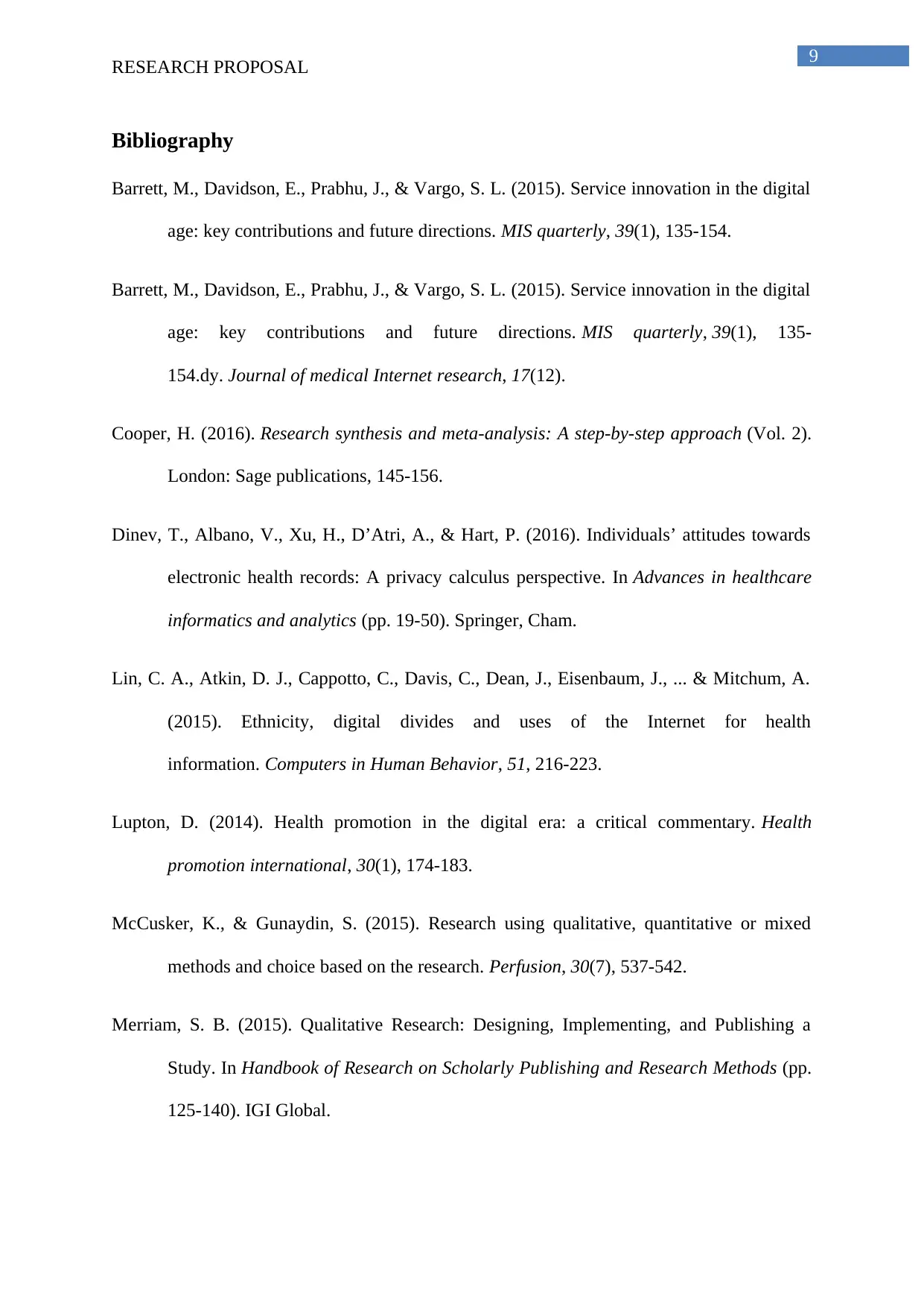
9
RESEARCH PROPOSAL
Bibliography
Barrett, M., Davidson, E., Prabhu, J., & Vargo, S. L. (2015). Service innovation in the digital
age: key contributions and future directions. MIS quarterly, 39(1), 135-154.
Barrett, M., Davidson, E., Prabhu, J., & Vargo, S. L. (2015). Service innovation in the digital
age: key contributions and future directions. MIS quarterly, 39(1), 135-
154.dy. Journal of medical Internet research, 17(12).
Cooper, H. (2016). Research synthesis and meta-analysis: A step-by-step approach (Vol. 2).
London: Sage publications, 145-156.
Dinev, T., Albano, V., Xu, H., D’Atri, A., & Hart, P. (2016). Individuals’ attitudes towards
electronic health records: A privacy calculus perspective. In Advances in healthcare
informatics and analytics (pp. 19-50). Springer, Cham.
Lin, C. A., Atkin, D. J., Cappotto, C., Davis, C., Dean, J., Eisenbaum, J., ... & Mitchum, A.
(2015). Ethnicity, digital divides and uses of the Internet for health
information. Computers in Human Behavior, 51, 216-223.
Lupton, D. (2014). Health promotion in the digital era: a critical commentary. Health
promotion international, 30(1), 174-183.
McCusker, K., & Gunaydin, S. (2015). Research using qualitative, quantitative or mixed
methods and choice based on the research. Perfusion, 30(7), 537-542.
Merriam, S. B. (2015). Qualitative Research: Designing, Implementing, and Publishing a
Study. In Handbook of Research on Scholarly Publishing and Research Methods (pp.
125-140). IGI Global.
RESEARCH PROPOSAL
Bibliography
Barrett, M., Davidson, E., Prabhu, J., & Vargo, S. L. (2015). Service innovation in the digital
age: key contributions and future directions. MIS quarterly, 39(1), 135-154.
Barrett, M., Davidson, E., Prabhu, J., & Vargo, S. L. (2015). Service innovation in the digital
age: key contributions and future directions. MIS quarterly, 39(1), 135-
154.dy. Journal of medical Internet research, 17(12).
Cooper, H. (2016). Research synthesis and meta-analysis: A step-by-step approach (Vol. 2).
London: Sage publications, 145-156.
Dinev, T., Albano, V., Xu, H., D’Atri, A., & Hart, P. (2016). Individuals’ attitudes towards
electronic health records: A privacy calculus perspective. In Advances in healthcare
informatics and analytics (pp. 19-50). Springer, Cham.
Lin, C. A., Atkin, D. J., Cappotto, C., Davis, C., Dean, J., Eisenbaum, J., ... & Mitchum, A.
(2015). Ethnicity, digital divides and uses of the Internet for health
information. Computers in Human Behavior, 51, 216-223.
Lupton, D. (2014). Health promotion in the digital era: a critical commentary. Health
promotion international, 30(1), 174-183.
McCusker, K., & Gunaydin, S. (2015). Research using qualitative, quantitative or mixed
methods and choice based on the research. Perfusion, 30(7), 537-542.
Merriam, S. B. (2015). Qualitative Research: Designing, Implementing, and Publishing a
Study. In Handbook of Research on Scholarly Publishing and Research Methods (pp.
125-140). IGI Global.
Paraphrase This Document
Need a fresh take? Get an instant paraphrase of this document with our AI Paraphraser
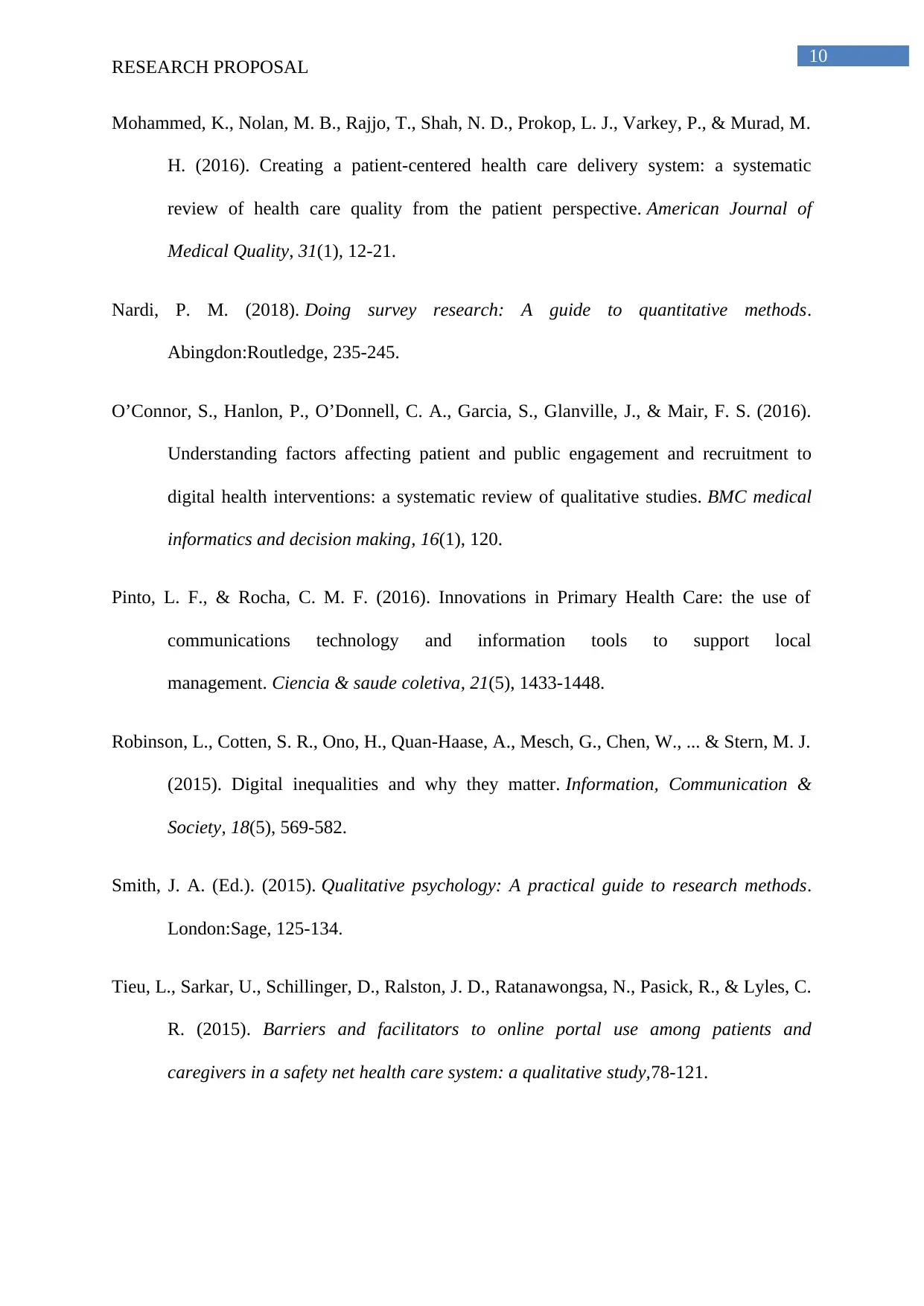
10
RESEARCH PROPOSAL
Mohammed, K., Nolan, M. B., Rajjo, T., Shah, N. D., Prokop, L. J., Varkey, P., & Murad, M.
H. (2016). Creating a patient-centered health care delivery system: a systematic
review of health care quality from the patient perspective. American Journal of
Medical Quality, 31(1), 12-21.
Nardi, P. M. (2018). Doing survey research: A guide to quantitative methods.
Abingdon:Routledge, 235-245.
O’Connor, S., Hanlon, P., O’Donnell, C. A., Garcia, S., Glanville, J., & Mair, F. S. (2016).
Understanding factors affecting patient and public engagement and recruitment to
digital health interventions: a systematic review of qualitative studies. BMC medical
informatics and decision making, 16(1), 120.
Pinto, L. F., & Rocha, C. M. F. (2016). Innovations in Primary Health Care: the use of
communications technology and information tools to support local
management. Ciencia & saude coletiva, 21(5), 1433-1448.
Robinson, L., Cotten, S. R., Ono, H., Quan-Haase, A., Mesch, G., Chen, W., ... & Stern, M. J.
(2015). Digital inequalities and why they matter. Information, Communication &
Society, 18(5), 569-582.
Smith, J. A. (Ed.). (2015). Qualitative psychology: A practical guide to research methods.
London:Sage, 125-134.
Tieu, L., Sarkar, U., Schillinger, D., Ralston, J. D., Ratanawongsa, N., Pasick, R., & Lyles, C.
R. (2015). Barriers and facilitators to online portal use among patients and
caregivers in a safety net health care system: a qualitative study,78-121.
RESEARCH PROPOSAL
Mohammed, K., Nolan, M. B., Rajjo, T., Shah, N. D., Prokop, L. J., Varkey, P., & Murad, M.
H. (2016). Creating a patient-centered health care delivery system: a systematic
review of health care quality from the patient perspective. American Journal of
Medical Quality, 31(1), 12-21.
Nardi, P. M. (2018). Doing survey research: A guide to quantitative methods.
Abingdon:Routledge, 235-245.
O’Connor, S., Hanlon, P., O’Donnell, C. A., Garcia, S., Glanville, J., & Mair, F. S. (2016).
Understanding factors affecting patient and public engagement and recruitment to
digital health interventions: a systematic review of qualitative studies. BMC medical
informatics and decision making, 16(1), 120.
Pinto, L. F., & Rocha, C. M. F. (2016). Innovations in Primary Health Care: the use of
communications technology and information tools to support local
management. Ciencia & saude coletiva, 21(5), 1433-1448.
Robinson, L., Cotten, S. R., Ono, H., Quan-Haase, A., Mesch, G., Chen, W., ... & Stern, M. J.
(2015). Digital inequalities and why they matter. Information, Communication &
Society, 18(5), 569-582.
Smith, J. A. (Ed.). (2015). Qualitative psychology: A practical guide to research methods.
London:Sage, 125-134.
Tieu, L., Sarkar, U., Schillinger, D., Ralston, J. D., Ratanawongsa, N., Pasick, R., & Lyles, C.
R. (2015). Barriers and facilitators to online portal use among patients and
caregivers in a safety net health care system: a qualitative study,78-121.

11
RESEARCH PROPOSAL
Wager, K. A., Lee, F. W., & Glaser, J. P. (2017). Health care information systems: a
practical approach for health care management. New Jersey:John Wiley & Sons, 55-
75.
Yardley, L., Spring, B. J., Riper, H., Morrison, L. G., Crane, D. H., Curtis, K., ... &
Blandford, A. (2016). Understanding and promoting effective engagement with digital
behavior change interventions. American journal of preventive medicine, 51(5), 833-
842.
RESEARCH PROPOSAL
Wager, K. A., Lee, F. W., & Glaser, J. P. (2017). Health care information systems: a
practical approach for health care management. New Jersey:John Wiley & Sons, 55-
75.
Yardley, L., Spring, B. J., Riper, H., Morrison, L. G., Crane, D. H., Curtis, K., ... &
Blandford, A. (2016). Understanding and promoting effective engagement with digital
behavior change interventions. American journal of preventive medicine, 51(5), 833-
842.
⊘ This is a preview!⊘
Do you want full access?
Subscribe today to unlock all pages.

Trusted by 1+ million students worldwide
1 out of 17
Related Documents
Your All-in-One AI-Powered Toolkit for Academic Success.
+13062052269
info@desklib.com
Available 24*7 on WhatsApp / Email
![[object Object]](/_next/static/media/star-bottom.7253800d.svg)
Unlock your academic potential
Copyright © 2020–2025 A2Z Services. All Rights Reserved. Developed and managed by ZUCOL.




